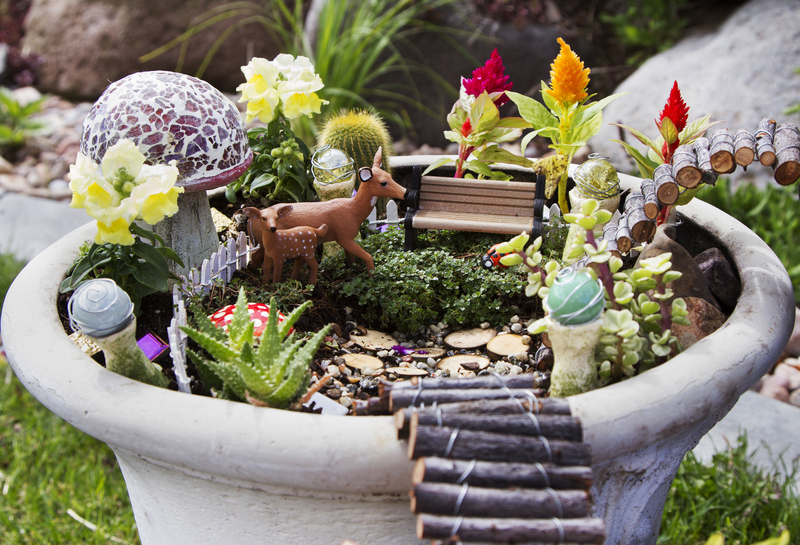Simple Steps to Protect Your Lawn from Drought Stress This Summer
Keeping a vibrant, green lawn through the scorching summer months can feel like a challenge, especially when confronted with periods of drought. However, with proper techniques and a little know-how, you can shield your lawn from the damaging effects of drought stress and maintain its health and beauty all season long.
Understanding Drought Stress in Lawns
Before diving into the steps for drought lawn care, it is crucial to understand what drought stress means for your lawn. When grass does not receive enough moisture--either due to lack of rainfall or water restrictions--your lawn begins to show signs of stress. This may include a bluish-gray tint, wilting blades, slow growth, or visible footprints that linger after walking.
What Causes Drought Stress?
- Extended periods of high heat
- Inadequate rainfall or irrigation
- Shallow root systems
- Compacted or poor-quality soil
- The use of fast-growing grass species that require more water
When not addressed, drought stress not only diminishes your lawn's appearance, but it can weaken the grass, making it more susceptible to diseases, weeds, and pests. Fortunately, with a proactive approach, you can protect your lawn from drought damage and minimize any negative impact.

Top Tips and Simple Steps to Shield Your Lawn from Drought
Let's explore a comprehensive set of strategies to help you prevent drought stress and maintain a lush, healthy landscape all summer long. These expert-recommended steps are easy to implement and proven to make a difference.
1. Choose the Right Grass Type for Drought-Prone Areas
Selecting a drought-tolerant grass species can be your lawn's first line of defense. Some grasses have naturally deeper roots or are better adapted to dry climates, requiring less water to stay green.
- Bermuda Grass: Popular in warm climates and renowned for excellent drought resistance.
- Zoysia Grass: Grows well in both sun and partial shade; requires minimal water once established.
- Buffalo Grass: Native to North America and thrives under low-water conditions.
- Tall Fescue: Deep-rooted and relatively drought resilient for cooler climates.
If you're planning to seed or resod, consider these varieties to help your lawn handle water scarcity more effectively.
2. Water Your Lawn the Smart Way
Efficient watering is critical for drought protection. Instead of frequent, shallow irrigation, deep and infrequent watering encourages roots to grow deeper, making your grass more resilient to drought.
- Early Morning Watering: Water between 4 a.m. and 9 a.m. to reduce evaporation and maximize water absorption.
- Water Deeply: Aim to wet the soil to a depth of 6-8 inches with each watering.
- Water Less Often: Typically, lawns need only 1 to 1.5 inches of water per week during the peak of summer. Adjust according to your soil and grass type.
- Use Sprinkler Timers: Set your sprinkler system to ensure even, scheduled watering and avoid waste.
Not sure if your lawn needs water? Employ the "step test": step on your grass - if it springs back, it's hydrated; if not, it's time to water.
3. Mow Higher and Maintain Your Mower's Blades
Proper mowing practices are essential for protecting grass during drought. Taller grass blades shade the soil, reduce evaporation, and encourage deeper rooting.
- Raise your mower's blade to the highest setting: Maintain a mowing height of 2.5 to 4 inches, depending on your grass type.
- Never remove more than one-third of the grass height in a single mow.
- Keep mower blades sharp: Dull blades tear the grass, increasing moisture loss.
- Leave clippings on the lawn: Grass clippings return valuable nutrients and help retain soil moisture.
4. Mulch and Topdress to Lock in Moisture
A thin layer of mulch or organic topdressing can help conserve soil moisture and moderate soil temperature. This is particularly helpful during extreme heat waves.
- Apply compost or fine mulch in spring or fall: A 1/4 -inch layer of compost provides nutrients and water retention benefits.
- Use grass clippings as a natural mulch: They help shade the grass roots and keep the underlying soil cool.
5. Aerate Your Lawn to Aid Water Penetration
Compacted soil is a major enemy of drought-resistant lawns. Regular aeration--removing small plugs of soil--improves water, nutrient, and air penetration to the root zone.
- Aerate at least once per year: Ideal in early spring or fall for cool-season grasses, late spring for warm-season grasses.
- Focus on high-traffic areas: These often become especially compacted and are prone to water runoff.
6. Fertilize Correctly--Not Excessively
Over-fertilizing during drought can harm your lawn. Excess fertilizer can "burn" grass, amplify water demand, and encourage weak, shallow root growth.
- Apply slow-release, low-nitrogen fertilizer in spring or early fall: Avoid high-nitrogen "quick green" products during peak summer heat.
- Test your soil: Soil analysis ensures you're supplying only the nutrients your lawn truly needs.
7. Control Weeds for Maximized Moisture Availability
Weeds compete with turfgrass for valuable water and nutrients, making it more challenging for your lawn to withstand drought.
- Hand-pull weeds regularly, especially after watering or rainfall
- Apply targeted herbicides if needed, but avoid broad-spectrum weed killers during drought stress
- Overseed your lawn in fall to thicken turf and naturally crowd out weeds
8. Consider Smart Irrigation & Rainwater Harvesting
Embrace modern solutions to minimize water usage and maximize lawn resilience.
- Install rain sensors or smart controllers: These devices prevent watering during rain and optimize irrigation cycles to match actual conditions.
- Use rain barrels: Collect roof runoff to naturally irrigate your garden during dry spells.
9. Limit Foot Traffic During Peak Heat
Foot traffic, play, or pet activity on parched lawns can fry delicate blades and worsen stress. Try to keep people and pets off the lawn during drought, or rotate play areas to prevent concentrated damage.
10. Monitor for Signs of Drought and Adjust Care
Stay vigilant for symptoms of water stress:
- Grass takes on a dull or bluish hue
- Blades fold or wilt
- Footprints or mower tracks stay visible long after stepping
Respond quickly by watering and providing appropriate lawn care during drought.
Additional Proactive Strategies for Enhanced Drought Protection
Soil Improvement & Lawn Renovation
- Amend soils with organic matter: Compost, peat moss, and humus improve water-holding capacity and drainage.
- Correct drainage issues: Level low spots and break up hardpan layers that cause runoff.
- Consider lawn alternatives: In especially arid regions, groundcovers or xeriscaping can reduce maintenance and water use.
Let Your Lawn Go Dormant--It's Natural!
Did you know? Most lawn grasses can survive weeks of drought by entering a dormant state. The blades may brown, but the roots remain alive and ready to regrow when moisture returns.
- If you allow dormancy, minimize disturbance (mowing, traffic, fertilizing) until rain returns.
- Provide 0.25" of water every 2-4 weeks to keep roots alive (not to actively green up the lawn).

Frequently Asked Questions: Lawn Drought Protection
Q: How often should I water my lawn during a drought?
A: During active drought, water once every 7-10 days, soaking the soil to a 6-8" depth. This deep, infrequent watering technique strengthens roots and helps grass withstand dry periods.
Q: Is it OK to fertilize my lawn during drought?
A: Do not fertilize during active drought or extreme heat unless using a very light, organic slow-release formula. Fertilizing encourages growth, which increases water demand.
Q: Can I mow my lawn during heat waves?
A: Yes, but always keep blades higher and mow less frequently. Never mow dormant or severely stressed lawns, as this can cause lasting damage.
Q: Should I reseed after drought?
A: If you notice large bare patches once the drought passes, consider overseeding with drought-tolerant varieties in early fall. Prepare the soil with light raking and keep new seeds moist (but not saturated) until established.
Conclusion: Achieve a Healthy, Resilient Lawn Through Smart Drought Strategies
Overcoming drought stress in your lawn is not about using more water, but about enabling your turfgrass to endure and recover from brief dry spells. By following these simple lawn care steps for drought--from smart watering and mowing to choosing resilient grass and improving soil--you can ensure a lush, thriving yard, even during the toughest summer heat.
With a proactive approach, a bit of patience, and making the most of modern, eco-friendly solutions, your lawn can continue to be an oasis--no matter how hot it gets this summer.
- Water wisely and deeply
- Mow higher
- Encourage deep root growth
- Foster healthy, thick turf
- Monitor for drought stress and adjust care accordingly
Start implementing these drought-protection steps today and enjoy a gorgeous, green lawn all summer long!